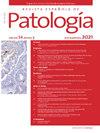Cytomorphological diagnosis of sarcoidosis using EBUS-TBNA in a tuberculosis-endemic region
IF 0.5
Q4 Medicine
引用次数: 0
Abstract
Background
Sarcoidosis, a granulomatous inflammatory disease, exhibits diverse clinical manifestations, often affecting multiple organs. Diagnostic challenges arise due to its similarities with tuberculosis, particularly in high-burden areas. Differentiating between the two relies on clinical judgment, laboratory tests, imaging, and invasive procedures. Endobronchial ultrasound-guided transbronchial needle aspiration (EBUS-TBNA) has emerged as a valuable diagnostic tool, enhancing both accuracy and patient care.
Material and methods
This study enrolled 279 suspected sarcoidosis cases, evaluated via EBUS-TBNA between November 2022 and August 2023. The inclusion criteria comprised intrathoracic lymphadenopathy on CT, with subsequent diagnoses of either sarcoidosis or tuberculosis. Clinical, radiological, and laboratory assessments, along with EBUS-TBNA, were conducted. Cytopathological analysis focused on the presence of granulomas, histiocytic clusters, lymphocyte depletion, and necrosis, which aided in diagnosis. Statistical analysis was conducted using SPSS software to evaluate sensitivity, specificity, and predictive values.
Results
Out of 279 patients, 178 were diagnosed with sarcoidosis and 90 with tuberculosis. Adequate TBNA samples were obtained in 240 cases, predominantly from male patients. Negative tuberculin skin tests and negative culture studies were significant findings in the sarcoidosis cases (p < 0.0001). Echotexture and necrosis were distinguishing features of tuberculosis, while granulomas and histiocyte patterns varied. The sensitivity and specificity for diagnosing sarcoidosis via cytomorphology were notable, particularly when combined with negative microbiological findings.
Conclusion
Cytomorphological analysis via EBUS-TBNA significantly aids in the diagnosis of sarcoidosis, despite overlapping features with tuberculosis. The absence of necrosis and distinctive granuloma characteristics contribute to its high sensitivity and specificity. Radiological correlations and microbiological findings further enhance diagnostic accuracy. This study underscores the importance of comprehensive evaluation in intrathoracic lymphadenopathies, highlighting the pivotal role of EBUS-TBNA in tuberculosis-endemic regions.
应用EBUS-TBNA对结核流行地区结节病的细胞形态学诊断。
背景:结节病是一种肉芽肿性炎症性疾病,临床表现多样,常累及多个器官。由于其与结核病相似,特别是在高负担地区,因此出现了诊断方面的挑战。区分两者依赖于临床判断、实验室检查、影像学和侵入性手术。超声引导下支气管穿刺(EBUS-TBNA)已成为一种有价值的诊断工具,提高了准确性和患者护理。材料和方法:本研究招募了279例疑似结节病病例,于2022年11月至2023年8月期间通过EBUS-TBNA进行评估。纳入标准包括CT上的胸内淋巴结病,随后诊断为结节病或结核病。进行了临床、放射学和实验室评估以及EBUS-TBNA。细胞病理学分析集中在肉芽肿,组织细胞簇,淋巴细胞耗损和坏死的存在,这有助于诊断。采用SPSS软件进行统计学分析,评价敏感性、特异性和预测值。结果:279例患者中结节病178例,结核90例。在240例患者中获得了足够的TBNA样本,主要来自男性患者。结核菌素皮肤试验阴性和培养阴性是结节病病例的重要发现。结论:尽管结节病与结核病有重叠的特征,但通过EBUS-TBNA进行细胞形态学分析有助于结节病的诊断。无坏死,肉芽肿特征明显,具有较高的敏感性和特异性。放射学相关性和微生物学结果进一步提高了诊断的准确性。这项研究强调了对胸内淋巴结病进行综合评估的重要性,强调了EBUS-TBNA在结核病流行地区的关键作用。
本文章由计算机程序翻译,如有差异,请以英文原文为准。
求助全文
约1分钟内获得全文
求助全文
来源期刊

Revista Espanola de Patologia
Medicine-Pathology and Forensic Medicine
CiteScore
0.90
自引率
0.00%
发文量
53
审稿时长
34 days
 求助内容:
求助内容: 应助结果提醒方式:
应助结果提醒方式:


